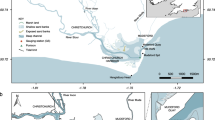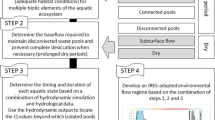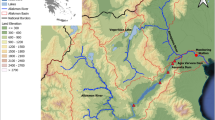Abstract
Many small estuaries and coastal lagoons in different parts of the world may be classified as temporarily closed/open ecosystems. They are blocked off from the sea for varying lengths of time by a sand bar, which forms at the estuarine mouth. The lengths of the closed and open phases, which are determined primarily by the interaction of river inflow and the sea in the mouth region, affect the structure and functioning of the estuarine biotic community. Freshwater inflow to such estuaries is normally not measured, and observations on the duration of estuarine mouth openings/closures are very scarce. As a result, relevant management decisions are often made on the basis of general experience and intuitive judgment. This paper describes an innovative approach for linking hydrologic data to mouth state in ungauged estuaries. A key characteristic in the method is the stream/river flow duration curve. It is first established for a daily index, which reflects the upstream catchment wetness and is calculated using rainfall information from the nearest rain gauge(s). This duration curve is then used to convert the current precipitation index time series into a continuous daily inflow time series at the ungauged estuarine mouth location. The conversion is based on the assumption that precipitation index values in a small catchment, and daily inflows to the estuarine mouth correspond to similar probabilities on their respective duration curves. The paper further illustrates how the generated inflow data could be used for the simulation of a continuous time series of estuary mouth openings/ closures. Inflows are routed through a reservoir model, and the estuary mouth is considered open on days when the spillage from an estuarine “reservoir” occurs. The approach is illustrated using limited observed data on estuary mouth conditions from the South African coastline.
Similar content being viewed by others
Literature Cited
Badenhorst, P. 1988. Report on the dynamics of the Kleinemonde west and east estuaries. Council for Scientific and Industrial Research (CSIR), Pretoria, South Africa. Report EM A/T 8805.
Begg, G. 1978. The estuaries of Natal. L. Backhouse, Pietermaritzburg, South Africa.
Coetzee, J. C., J. B. Adams, and G. C. Bate. 1997. A botanical importance rating system for estuaries. Journal of Coastal Conservation 2:131–138.
Congdon, R. A. and A. J. McComb. 1986. Aspects of the hydrology and plant ecology of the two normally closed estuaries in the south coast of Western Australia. Wetlands 10:23–32.
Cooper, J. A. G. 2001. Geomorphological variability among microtidal estuaries from the wave-dominated South African coast. Geomorphology 40:99–122.
Cooper, J. A. G., T. R. Mason, J. S. V. Reddering, and W. K. Illenberger. 1990. Geomorphological effects of catastrophic fluvial flooding on a small subtropical estuary. Earth Surface Processes and Landforms 15:25–41.
Cooper, J. A. G., C. I. Wright, and T. R. Mason. 1999. Geomorphology and sedimentology. p. 5–25. In B. R. Allanson and D. Baird (eds.) Estuaries of South Africa. Cambridge University Press, Cambridge, UK.
Day, J. H. 1981a. The nature, origin and classification of estuaries. p. 1–6. In J. H. Day (ed.) Estuarine Ecology with Particular Reference to Southern Africa. A. Balkema, Cape Town, South Africa.
Day, J. H. 1981b. Summaries of current knowledge of 43 estuaries in southern Africa. p. 251–329. In J. H. Day (ed.) Estuarine Ecology with Particular Reference to Southern Africa. A. Balkema, Cape Town, South Africa.
Fox, H. R., R. L. Wilby, and H. M. Moore. 2001. The impact of river regulation and climate change on the barred estuary of the Oued Massa, southern Morocco. Regulated Rivers: Research and Management 17:235–250.
Griffiths, S. P. 2001. Factors influencing fish composition in an Australian intermittently open estuary. Is stability salinity-dependent? Estuarine, Coastal and Shelf Science 52:739–751.
Hockey, P. A. R. and J. K. Turpie. 1999. Estuarine birds in South Africa. p. 235–268. In B. R. Allanson and D. Baird (eds.) Estuaries of South Africa. Cambridge University Press. Cambridge, UK.
Hughes, D. A. and V. U. Smakhtin. 1996. Daily flow data time series patching or extension, a spatial interpolation approach based on flow duration curves. Journal of Hydrological Sciences 41:851–871.
Hughes, D. A. and G. Ziervogel. 1998. The inclusion of operating rules in a daily reservoir simulation model to determine ecological reserve releases for river maintenance. Water SA 24:293–302.
Linsley, R. K., M. A. Kohler, and J. L. H. Paulhus. 1988. Hydrology for Engineers, SI metric edition. McGraw-Hill, New York, NY, USA.
Midgley, D. C., W. V. Pitman, and B. J. Middleton. 1994. Surface water resources of South Africa 1990. Water Research Commission, Pretoria, South Africa, Reports N 298/1.1/94-298/6.1.
Roy, P. S., R. J. Williams, A. R. Jones, I. Yassini, P. J. Gibbs, B. Coates, R. J. West, P. R. Scanes, J. P. Hudson, and S. Nichol. 2001. Structure and functions of South-East Australian estuaries. Estuarine, Coastal and Shelf Science 53:351–384.
Smakhtin, V. U. 1999. Generation of natural daily flow time-series in regulated rivers using a non-linear spatial interpolation technique. Regulated Rivers: Research and Management 15:311–323.
Smakhtin, V. U. 2000. Estimating daily flow duration curves from monthly streamflow data. Water SA 26:13–18.
Smakhtin, V. U., E. Creuse-Naudine, and D. A. Hughes. 1997. Regionalisation of daily flow characteristics in part of the Eastern Cape, South Africa. Journal of Hydrological Sciences 42:919–936.
Smakhtin, V. U. and B. Masse. 2000. Continuous daily hydrograph simulation using duration curves of precipitation index. Hydrological Processes 14:1083–1100.
Smakhtin, V. U. 2001. Low flow hydrology: a review. Journal of Hydrology 240:147–186.
Whitfield, A. K. 1978. The importance of the tidal cycle to wading birds on mud flats. Bokmakierie 30:24–25.
Whitfield, A. K. 1992. A characterization of Southern African estuarine systems. South African Journal of Aquatic Sciences 18:89–103.
Whitfield, A. K. 2000. Available scientific information on individual South African estuarine systems. Water Research Commission, Pretoria, South Africa Report No 577/3/00.
Whitfield, A. K. and J. F. K. Marais. 1999. The ichthyofauna p. 209–233. In B. R. Allanson and D. Baird (eds.) Estuaries of South Africa. Cambridge University Press, Cambridge, UK.
Author information
Authors and Affiliations
Rights and permissions
About this article
Cite this article
Smakhtin, V.U. Simulating the hydrology and mouth conditions of small, temporarily closed/open estuaries. Wetlands 24, 123–132 (2004). https://doi.org/10.1672/0277-5212(2004)024[0123:STHAMC]2.0.CO;2
Received:
Revised:
Accepted:
Issue Date:
DOI: https://doi.org/10.1672/0277-5212(2004)024[0123:STHAMC]2.0.CO;2




